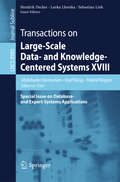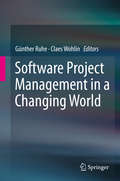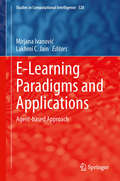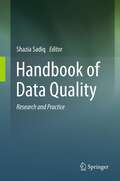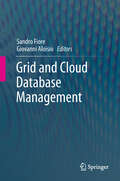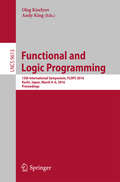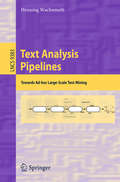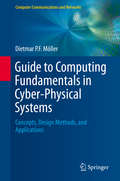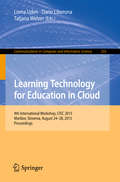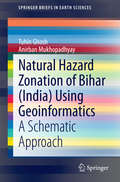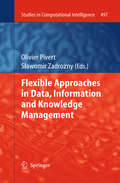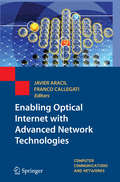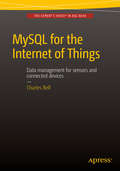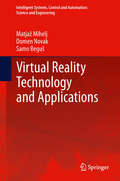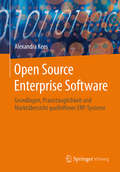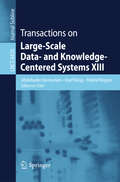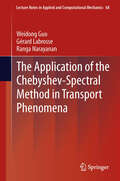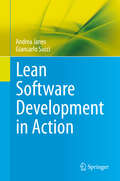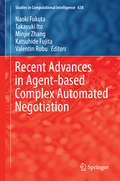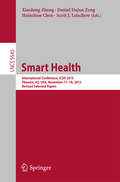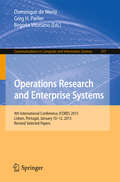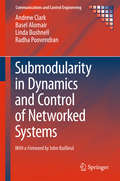- Table View
- List View
Transactions on Large-Scale Data- and Knowledge-Centered Systems XVIII
by Abdelkader Hameurlain Josef Küng Roland Wagner Hendrik Decker Lenka Lhotska Sebastian LinkThe LNCS journal Transactions on Large-Scale Data- and Knowledge-Centered Systems focuses on data management, knowledge discovery, and knowledge processing, which are core and hot topics in computer science. Since the 1990s, the Internet has become the main driving force behind application development in all domains. An increase in the demand for resource sharing across different sites connected through networks has led to an evolution of data- and knowledge-management systems from centralized systems to decentralized systems enabling large-scale distributed applications providing high scalability. Current decentralized systems still focus on data and knowledge as their main resource. Feasibility of these systems relies basically on P2P (peer-to-peer) techniques and the support of agent systems with scaling and decentralized control. Synergy between grids, P2P systems, and agent technologies is the key to data- and knowledge-centered systems in large-scale environments. This, the 18th issue of Transactions on Large-Scale Data- and Knowledge-Centered Systems, contains extended and revised versions of seven papers presented at the 24th International Conference on Database and Expert Systems Applications, DEXA 2013, held in Prague, in the Czech Republic, in August 2013. Following the conference, and two further rounds of reviewing and selection, five extended papers and two invited keynote papers were chosen for inclusion in this special issue. The subject areas covered include argumentation, e-government, business processes, predictive traffic estimation, semantic model integration, top-k query processing, uncertainty handling, graph comparison, community detection, genetic programming, and web services.
Software Project Management in a Changing World
by Claes Wohlin Günther RuheBy bringing together various current directions, Software Project Management in a Changing World focuses on how people and organizations can make their processes more change-adaptive. The selected chapters closely correspond to the project management knowledge areas introduced by the Project Management Body of Knowledge, including its extension for managing software projects. The contributions are grouped into four parts, preceded by a general introduction. Part I "Fundamentals" provides in-depth insights into fundamental topics including resource allocation, cost estimation and risk management. Part II "Supporting Areas" presents recent experiences and results related to the management of quality systems, knowledge, product portfolios and global and virtual software teams. Part III "New Paradigms" details new and evolving software-development practices including agile, distributed and open and inner-source development. Finally, Part IV "Emerging Techniques" introduces search-based techniques, social media, software process simulation and the efficient use of empirical data and their effects on software-management practices. This book will attract readers from both academia and practice with its excellent balance between new findings and experience of their usage in new contexts. Whenever appropriate, the presentation is based on evidence from empirical evaluation of the proposed approaches. For researchers and graduate students, it presents some of the latest methods and techniques to accommodate new challenges facing the discipline. For professionals, it serves as a source of inspiration for refining their project-management skills in new areas.
E-Learning Paradigms and Applications
by Lakhmi C. Jain Mirjana IvanovićTeaching and learning paradigms have attracted increased attention especially in the last decade. Immense developments of different ICT technologies and services have paved the way for alternative but effective approaches in educational processes. Many concepts of the agent technology, such as intelligence, autonomy and cooperation, have had a direct positive impact on many of the requests imposed on modern e-learning systems and educational processes. This book presents the state-of-the-art of e-learning and tutoring systems and discusses their capabilities and benefits that stem from integrating software agents. We hope that the presented work will be of a great use to our colleagues and researchers interested in the e-learning and agent technology.
Übungsaufgaben zur Mathematik für Ingenieure: Mit durchgerechneten und erklärten Lösungen
by Thomas RießingerDieses erfolgreiche Übungsbuch erscheint jetzt in der 6. Auflage. Der Autor rechnet 159 Übungsaufgaben zur Ingenieurmathematik im Detail vor und erklärt sie. Im Gegensatz zu vielen anderen Übungsbüchern zur Mathematik werden hier nicht nur Ergebnisse oder bestenfalls Lösungsskizzen angegeben. Vielmehr zeigt der Autor, wie man solche Aufgaben vom ersten Ansatz bis zum Ergebnis durchrechnet. Anhand von Beispielen erklärt er die prinzipiellen Methoden, die bei den Aufgaben angewendet werden. Übungsbuch und Lehrbuch "Mathematik für Ingenieure" desselben Autors sind aufeinander abgestimmt.
Handbook of Data Quality: Research and Practice
by Shazia SadiqThe issue of data quality is as old as data itself. However, the proliferation of diverse, large-scale and often publically available data on the Web has increased the risk of poor data quality and misleading data interpretations. On the other hand, data is now exposed at a much more strategic level e.g. through business intelligence systems, increasing manifold the stakes involved for individuals, corporations as well as government agencies. There, the lack of knowledge about data accuracy, currency or completeness can have erroneous and even catastrophic results. With these changes, traditional approaches to data management in general, and data quality control specifically, are challenged. There is an evident need to incorporate data quality considerations into the whole data cycle, encompassing managerial/governance as well as technical aspects. Data quality experts from research and industry agree that a unified framework for data quality management should bring together organizational, architectural and computational approaches. Accordingly, Sadiq structured this handbook in four parts: Part I is on organizational solutions, i.e. the development of data quality objectives for the organization, and the development of strategies to establish roles, processes, policies, and standards required to manage and ensure data quality. Part II, on architectural solutions, covers the technology landscape required to deploy developed data quality management processes, standards and policies. Part III, on computational solutions, presents effective and efficient tools and techniques related to record linkage, lineage and provenance, data uncertainty, and advanced integrity constraints. Finally, Part IV is devoted to case studies of successful data quality initiatives that highlight the various aspects of data quality in action. The individual chapters present both an overview of the respective topic in terms of historical research and/or practice and state of the art, as well as specific techniques, methodologies and frameworks developed by the individual contributors. Researchers and students of computer science, information systems, or business management as well as data professionals and practitioners will benefit most from this handbook by not only focusing on the various sections relevant to their research area or particular practical work, but by also studying chapters that they may initially consider not to be directly relevant to them, as there they will learn about new perspectives and approaches.
Grid and Cloud Database Management
by Giovanni Aloisio Sandro FioreSince the 1990s Grid Computing has emerged as a paradigm for accessing and managing distributed, heterogeneous and geographically spread resources, promising that we will be able to access computer power as easily as we can access the electric power grid. Later on, Cloud Computing brought the promise of providing easy and inexpensive access to remote hardware and storage resources. Exploiting pay-per-use models and virtualization for resource provisioning, cloud computing has been rapidly accepted and used by researchers, scientists and industries. In this volume, contributions from internationally recognized experts describe the latest findings on challenging topics related to grid and cloud database management. By exploring current and future developments, they provide a thorough understanding of the principles and techniques involved in these fields. The presented topics are well balanced and complementary, and they range from well-known research projects and real case studies to standards and specifications, and non-functional aspects such as security, performance and scalability. Following an initial introduction by the editors, the contributions are organized into four sections: Open Standards and Specifications, Research Efforts in Grid Database Management, Cloud Data Management, and Scientific Case Studies. With this presentation, the book serves mostly researchers and graduate students, both as an introduction to and as a technical reference for grid and cloud database management. The detailed descriptions of research prototypes dealing with spatiotemporal or genomic data will also be useful for application engineers in these fields.
Natural Language Processing and Information Systems
by Farid Meziane Elisabeth Métais Mohamad Saraee Vijayan Sugumaran Sunil VaderaThis book constitutes the refereed proceedings of the 21st International Conference on Applications of Natural Language to Information Systems, NLDB 2016, held in Salford, UK, in June 2016. The 17 full papers, 22 short papers, and 13 poster papers presented were carefully reviewed and selected from 83 submissions. The papers cover the following topics: theoretical aspects, algorithms, applications, architectures for applied and integrated NLP, resources for applied NLP, and other aspects of NLP.
Functional and Logic Programming
by Andy King Oleg KiselyovThis bookconstitutes the proceedings of the 13th International Symposium on Functionaland Logic Programming, FLOPS 2016, held in Kochi, Japan, in March 2016. The 14 papers presented in this volume were carefully reviewed and selectedfrom 36 submissions. They cover the following topics: functional and logicprogramming; program transformation and re-writing; and extracting programsfrom proofs of their correctness.
Text Analysis Pipelines
by Henning WachsmuthThis monograph proposes a comprehensive and fully automatic approach to designing text analysis pipelines for arbitrary information needs that are optimal in terms of run-time efficiency and that robustly mine relevant information from text of any kind. Based on state-of-the-art techniques from machine learning and other areas of artificial intelligence, novel pipeline construction and execution algorithms are developed and implemented in prototypical software. Formal analyses of the algorithms and extensive empirical experiments underline that the proposed approach represents an essential step towards the ad-hoc use of text mining in web search and big data analytics. Both web search and big data analytics aim to fulfill peoples' needs for information in an adhoc manner. The information sought for is often hidden in large amounts of natural language text. Instead of simply returning links to potentially relevant texts, leading search and analytics engines have started to directly mine relevant information from the texts. To this end, they execute text analysis pipelines that may consist of several complex information-extraction and text-classification stages. Due to practical requirements of efficiency and robustness, however, the use of text mining has so far been limited to anticipated information needs that can be fulfilled with rather simple, manually constructed pipelines.
Guide to Computing Fundamentals in Cyber-Physical Systems
by Dietmar P. F. MöllerThis book presents an in-depth review of the state of the art ofcyber-physical systems (CPS) and their applications. Relevant case studies arealso provided, to help the reader to master the interdisciplinary material. Features: includes self-testexercises in each chapter, together with a glossary; offers a variety of teachingsupport materials at an associated website, including a comprehensive set ofslides and lecture videos; presents a brief overview of the study of systems,and embedded computing systems, before defining CPS; introduces the concepts ofthe Internet of Things, and ubiquitous (or pervasive) computing; reviews thedesign challenges of CPS, and their impact on systems and software engineering;describes the ideas behind Industry 4. 0 and the revolutions in digitalmanufacturing, including smart and agile manufacturing, as well ascybersecurity in manufacturing; considers the social impact of the changes inskills required by the globalized, digital work environment of the future.
Metaheuristics for Production Systems
by Lionel Amodeo Farouk Yalaoui El-Ghazali TalbiThis book discusses the main techniques and newest trends to manage and optimize the production and service systems. The book begins by examining the three main levels of decision systems in production: the long term (strategic), the middle term (tactical) and short term (operational). It also considers online management as a new level (a sub level of the short term). As each level encounters specific problems, appropriate approaches to deal with these are introduced and explained. These problems include the line design, the line balancing optimization, the physical layout of the production or service system, the forecasting optimization, the inventory management, the scheduling etc. Metaheuristics for Production Systems then explores logistic optimization from two different perspectives: internal (production management), addressing issues of scheduling, layout and line designs, and external (supply chain management) focusing on transportation optimization, supply chain evaluation, and location of production. The book also looks at NP-hard problems that are common in production management. These complex configurations may mean that optimal solutions may not be reached due to variables, but the authors help provide a good solution for such problems. The effective new results and solutions offered in this book should appeal to researchers, managers, and engineers in the production and service industries.
Learning Technology for Education in Cloud
by Lorna Uden Dario Liberona Tatjana WelzerThis book constitutes the refereed proceedings of the Fourth International Workshop on Learning Technology for Education in Cloud, LTEC 2015, held in Maribor, Slovenia, in August 2015. The 24 revised full papers presented were carefully reviewed and selected from 46 submissions. The papers cover various aspects of technologies for learning, such as MOOC challenges; cooperative learning; learning engineering; learning tools and environments; STEM.
Natural Hazard Zonation of Bihar (India) Using Geoinformatics
by Tuhin Ghosh Anirban MukhopadhyayWith increased climate variability, aggravated natural hazards in the form of extreme events are affecting the lives and livelihoods of many people. This work serves as a basis for formulating a 'preparedness plan' to ensure the effective policy formulation for planned development. Increased demand and competition with a high degree of variability have forced people to struggle in order to prosper. Good governance and innovative policy formulation are necessary to create a resilient society. This may promote a paradigm shift in the mindset on and perceptions of natural hazards and their impacts on development and growth. This new perspective will make people more concerned about minimizing the loss of life, property, and environmental damage and directly safeguard the development process. This book presents a detailed methodological approach to monitoring meteorological, hydrological, and climate change aspects to help resolve issues related to our environment, resources, and economies in the changing climate situation.
Flexible Approaches in Data, Information and Knowledge Management
by Olivier Pivert Sławomir ZadrożnyThis volume showcases contributions from internationally-known researchers in the field of information management. Most of the approaches presented here make use of fuzzy logic, introduced by L. A. Zadeh almost 50 years ago, which constitute a powerful tool to model and handle gradual concepts. What all of these contributions have in common is placing the user at the center of the information system, be it for helping him/her to query a data set, to handle imperfect information, or to discover useful knowledge from a massive collection of data. Researchers working in data and knowledge management will greatly benefit from this collection of up-to-date studies. This may be also an invaluable source of information for postgraduate students interested in advanced information management techniques.
Enabling Optical Internet with Advanced Network Technologies
by Javier Aracil Franco CallegatiThis reference provides an overview of the key concepts related to the major issues of optical Internet, and studies traditionally and recently proposed optical switching paradigms. The concise coverage presents a detailed comparison of optical switching technologies, and covers architectural issues together with topics such as signaling protocols and Quality of Service (QoS) provision. Additionally, the book provides deep insight into recent advances in optical circuit switching, optical packet switching (OPS) and optical burst switching (OBS) technologies; their performance advantages, their control-plane specifications, their enabling technologies, their applicability in today's networks, and their cost benefits. Readers need only undergraduate background in computer communication networks on topics related to TCP/IP, SDH and MPLS networks. This text will be a valuable resource for advanced undergraduates, beginning graduates, and researchers studying communications in Engineering and Computer Science.
MySQL for the Internet of Things
by Charles BellThis book introduces the problems facing Internet of Things developers and explores current technologies and techniques to help you manage, mine, and make sense of the data being collected through the use of the world's most popular database on the Internet - MySQL. The IoT is poised to change how we interact with and perceive the world around us, and the possibilities are nearly boundless. As more and more connected devices generate data, we will need to solve the problem of how to collect, store, and make sense of IoT data by leveraging the power of database systems. The book begins with an introduction of the MySQL database system and storage of sensor data. Detailed instructions and examples are provided to show how to add database nodes to IoT solutions including how to leverage MySQL high availability, including examples of how to protect data from node outages using advanced features of MySQL. The book closes with a comparison of raw and transformed data showing how transformed data can improve understandability and help you cut through a clutter of superfluous data toward the goal of mining nuggets of useful knowledge. What you'll learn Understand the crisis of vast volumes of data from connected devices Transform data to improve reporting and reduce storage volume Store and aggregate your IoT data across multiple database servers Build localized, low-cost MySQL database servers using small and inexpensive computers Connect Arduino boards and other devices directly to MySQL database servers Build high availability MySQL solutions among low-power computing devices Who this book is for MySQL for the Internet of Things is intended for both hobbyists and professionals who want to learn how to manage their IoT data. Table of Contents 1. The Internet of Things and Data 2. How IOT Data is Stored 3. Hardware for IOT Devices and Data Collection 4. Data Transformation 5. MySQL Primer 6. Building Low-Cost MySQL Database Nodes 7. High Availability IOT Solutions 8. Demonstration of Techniques
Virtual Reality Technology and Applications
by Matjaž Mihelj Domen Novak Samo BegusAs virtual reality expands from the imaginary worlds of science fiction and pervades every corner of everyday life, it is becoming increasingly important for students and professionals alike to understand the diverse aspects of this technology. This book aims to provide a comprehensive guide to the theoretical and practical elements of virtual reality, from the mathematical and technological foundations of virtual worlds to the human factors and the applications that enrich our lives: in the fields of medicine, entertainment, education and others. After providing a brief introduction to the topic, the book describes the kinematic and dynamic mathematical models of virtual worlds. It explores the many ways a computer can track and interpret human movement, then progresses through the modalities that make up a virtual world: visual, acoustic and haptic. It explores the interaction between the actual and virtual environments, as well as design principles of the latter. The book closes with an examination of different applications, focusing on augmented reality as a special case. Though the content is primarily VR-related, it is also relevant for many other fields.
Open Source Enterprise Software
by Alexandra KeesAnhand eines Marktspiegels erhalten Anwender mit dem Buch einen Überblick über die am Markt angebotene Free and Open Source (FOS) Software im Bereich der Enterprise Resource Planning Systeme (ERP-Systeme). FOS Software ist ein idealer Ansatz zur Kostenminimierung im IT-Bereich - dies gilt insbesondere für FOS ERP-Systeme. Die Durchdringung von Free and Open Source ERP-Systemen ist aber noch sehr gering. Ursache hierfür ist vor allem die Unübersichtlichkeit des Marktes. Ziel des vorliegenden Buches ist es daher, eine praxisnahe Einführung in FOS Unternehmenssoftware zu geben und einen Marktspiegel anzubieten, der als Grundlage für die Softwareauswahl von FOS ERP-Systeme genutzt werden kann.
Transactions on Large-Scale Data- and Knowledge-Centered Systems XIII
by Abdelkader Hameurlain Josef Küng Roland WagnerThis, the 13th issue of Transactions on Large-Scale Data and Knowledge-Centered Systems, contains six revised selected regular papers. Topics covered include federated data sources, information filtering, web data clouding, query reformulation, package skyline queries and SPARQL query processing over a LaV (Local-as-View) integration system.
The Application of the Chebyshev-Spectral Method in Transport Phenomena
by Ranga Narayanan Gérard Labrosse Weidong GuoTransport phenomena problems that occur in engineering and physics are often multi-dimensional and multi-phase in character. When taking recourse to numerical methods the spectral method is particularly useful and efficient. The book is meant principally to train students and non-specialists to use the spectral method for solving problems that model fluid flow in closed geometries with heat or mass transfer. To this aim the reader should bring a working knowledge of fluid mechanics and heat transfer and should be readily conversant with simple concepts of linear algebra including spectral decomposition of matrices as well as solvability conditions for inhomogeneous problems. The book is neither meant to supply a ready-to-use program that is all-purpose nor to go through all manners of mathematical proofs. The focus in this tutorial is on the use of the spectral methods for space discretization, because this is where most of the difficulty lies. While time dependent problems are also of great interest, time marching procedures are dealt with by briefly introducing and providing a simple, direct, and efficient method. Many examples are provided in the text as well as numerous exercises for each chapter. Several of the examples are attended by subtle points which the reader will face while working them out. Some of these points are deliberated upon in endnotes to the various chapters, others are touched upon in the book itself.
Lean Software Development in Action
by Giancarlo Succi Andrea JanesThis book illustrates how goal-oriented, automated measurement can be used to create Lean organizations and to facilitate the development of Lean software, while also demonstrating the practical implementation of Lean software development by combining tried and trusted tools. In order to be successful, a Lean orientation of software development has to go hand in hand with a company's overall business strategy. To achieve this, two interrelated aspects require special attention: measurement and experience management. In this book, Janes and Succi provide the necessary knowledge to establish "Lean software company thinking," while also exploiting the latest approaches to software measurement. A comprehensive, company-wide measurement approach is exactly what companies need in order to align their activities to the demands of their stakeholders, to their business strategy, etc. With the automatic, non-invasive measurement approach proposed in this book, even small and medium-sized enterprises that do not have the resources to introduce heavyweight processes will be able to make their software development processes considerably more Lean. The book is divided into three parts. Part I, "Motivation for Lean Software Development," explains just what "Lean Production" means, why it can be advantageous to apply Lean concepts to software engineering, and which existing approaches are best suited to achieving this. Part II, "The Pillars of Lean Software Development," presents the tools needed to achieve Lean software development: Non-invasive Measurement, the Goal Question Metric approach, and the Experience Factory. Finally, Part III, "Lean Software Development in Action," shows how different tools can be combined to enable Lean Thinking in software development. The book primarily addresses the needs of all those working in the field of software engineering who want to understand how to establish an efficient and effective software development process. This group includes developers, managers, and students pursuing an M. Sc. degree in software engineering.
Recent Advances in Agent-based Complex Automated Negotiation
by Minjie Zhang Takayuki Ito Katsuhide Fujita Valentin Robu Naoki FukutaThis bookcovers recent advances in Complex Automated Negotiations as a widely studiedemerging area in the field of Autonomous Agents and Multi-Agent Systems. The book includes selectedrevised and extended papers from the 7th International Workshop on Agent-Based ComplexAutomated Negotiation (ACAN2014), which was held in Paris, France, in May2014. The book also includes brief introductions aboutAgent-based Complex Automated Negotiation which are based on tutorials providedin the workshop, and brief summaries and descriptions about the ANAC'14 (AutomatedNegotiating Agents Competition) competition, where authors of selectedfinalist agents explain the strategies and the ideas used by them. Thebook is targeted to academic and industrial researchers in various communitiesof autonomous agents and multi-agent systems, such as agreement technology,mechanism design, electronic commerce, related areas, as well as graduate,undergraduate, and PhD students working in those areas or having interest inthem.
Smart Health
by Hsinchun Chen Xiaolong Zheng Daniel Dajun Zeng Scott J. LeischowThis book constitutes the thoroughly refereedpost-conference proceedings of the International Conference for Smart Health,ICSH 2015, held in Phoenix, AZ, USA, in November 2015. The 33 papers presented together were carefully reviewedand selected from 43 submissions. The conference focused on topics and issuesincluding medical monitoring and information extraction, clinical and medicaldata mining, health data analysis and management, big data and smart health,and healthcare intelligent systems and clinical practice.
Operations Research and Enterprise Systems
by Dominique De Werra Greg H. Parlier Begoña VitorianoThis bookconstitutes revised selected papers from the 4th InternationalConference on Operations Research and Enterprise Systems, ICORES 2015, held inLisbon, Portugal, in January 2015. The 14papers presented in this volume were carefully reviewed and selection from atotal of 89 submissions. They were organized in topical sections named: methodologiesand technologies; and applications.
Submodularity in Dynamics and Control of Networked Systems
by Andrew Clark Basel Alomair Linda Bushnell Radha PoovendranThis book presents a framework for the control of networked systems utilizing submodular optimization techniques. The main focus is on selecting input nodes for the control of networked systems, an inherently discrete optimization problem with applications in power system stability, social influence dynamics, and the control of vehicle formations. The first part of the book is devoted to background information on submodular functions, matroids, and submodular optimization, and presents algorithms for distributed submodular optimization that are scalable to large networked systems. In turn, the second part develops a unifying submodular optimization approach to controlling networked systems based on multiple performance and controllability criteria. Techniques are introduced for selecting input nodes to ensure smooth convergence, synchronization, and robustness to environmental and adversarial noise. Submodular optimization is the first unifying approach towards guaranteeing both performance and controllability with provable optimality bounds in static as well as time-varying networks. Throughout the text, the submodular framework is illustrated with the help of numerical examples and application-based case studies in biological, energy and vehicular systems. The book effectively combines two areas of growing interest, and will be especially useful for researchers in control theory, applied mathematics, networking or machine learning with experience in submodular optimization but who are less familiar with the problems and tools available for networked systems (or vice versa). It will also benefit graduate students, offering consistent terminology and notation that greatly reduces the initial effort associated with beginning a course of study in a new area.
